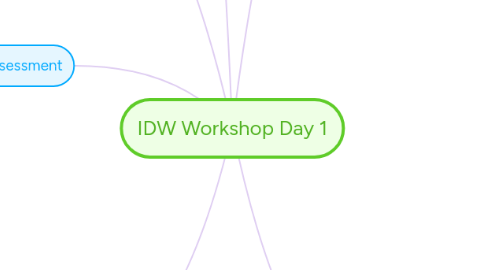
1. Part 3-WAC & WID
1.1. Activity: Using google drive, free write for 4 minutes- What is writing? share highlights of your free write with group
1.1.1. examples: writing is communication, a heavy chest or an opportunity for freedom of thought.
1.2. Writing across the curriculum/writing in the disciplines
1.3. Historical Perspectives: Johnny could never write! Harvard, Newsweek, Applebee-->all examples since the 1870s of differing views on what writing means, students writing for instructors
1.4. Theoretical Underpinnings of Writing
1.4.1. Knowledge Discovery, Susan McLeod, meaningful engagement with content
1.5. Rhetorical Theory
1.5.1. Disciplines in certain fields have ways of writing: graffiti is its own genre, with rules, expectations; screen writing vs. story boarding differs
1.6. Discovery and Display: Susan McLeod Theory (see slide)
2. Part 4-IDW Assessment
2.1. Worth Pickering-Assistant Vice President QEP is all driven by SACS, most intense of accrediting bodies, value added assessments, pretest on faculty learning of writing in college
2.1.1. Must add Remica as a TA in Blackboard for IDW to assess pre workshop assignments, or send via email to [email protected] if only have electronic copies
2.2. Goals: Introduce the role of assessment and student learning, realized last year we weren't attending to all student learning outcomes, needs to be a part of initial conversation
2.3. Concept Mapping: Have students in distance learning courses use apps like Mindomo.com and popplet.com to create and share concept maps
2.4. How do we extend composition course writing through disciplinary writing and connect the dots throughout: See concept map from notes
2.4.1. IDW Grading Rubric, AACU provides about 15 value rubrics for grading critical thinking assignments for free
2.4.1.1. IDW Rubric is compilation of 4 AACU rubrics, created by IDW faculty
2.5. Free Write: What is assessment? It is not grading. After the grading, how are we really doing in achieving student learning goals.
2.5.1. Assessment Defined: Outcomes, Opportunities, Evidence, and Improvements (Suskie, 2009)
2.5.1.1. Student learning at heart of assessment; can get to students through faculty
2.6. Several participants have real concerns about student assessment of classes, university assessment of how classes meet learning outcomes, and the effect that these have on promotion and tenure, particularly as they pertain to heavy writing courses (that students dislike).
3. Part 5-Writing to Learn
3.1. wordle exercises can stimulate thinking/learning/imagination, group surveys about word definitions, low-stakes work
3.2. Examples of "thinking on paper": making lists, journaling, notes on margins, speaking notes into phone for recording, notecards,
3.3. Low-Stakes Discovery Writing: meaningful so that they take seriously, but low stakes
4. HOMEWORK: Read Bean Chapters 3, 6,8; Post-current unrevised syllabus of the course you will be revising during IDW and a handout/directions for major paper assignment
5. Part 2-What is Learning? Jennifer Kid
5.1. How do people learn?
5.1.1. Does the idea stay the same, plug & play, or direct link?
5.1.1.1. Activity: Draw a picture of how you think people learn. Each participant drew a picture with crayons about how people learn. Wide variety of perspectives on learning. Interactions, senses, detection of patterns (grouping), feedback loops, processing information in networks, how idea fits with what we already know, sparking ideas-engaging students-losing students, etc.
5.1.1.2. Question was raised: how does reading for leisure effect writing skills? Does the technology craze with text messaging and social media reading adequately replace fiction book reading for enhanced learning?
5.1.2. Learners Construct, not record knowledge.
5.1.3. Build on prior knowledge
5.1.4. Structure Matters-info must be organized and presented logically
5.1.4.1. Chunking of info: induction vs deduction
5.1.5. Not too much at once! most common mistake is relaying TOO much info.
5.1.5.1. Example: Too many course objectives on syllabus,textbooks covering too much info
5.1.5.2. Multitasking doesn't work!!
5.1.6. Requires Practice
5.1.6.1. re-exposure to same info, opportunities to retrieve and apply knowledge in novel ways, questions!
5.1.7. Feedback
5.1.7.1. Engage students in review process
5.1.7.2. Summative vs. formative feedback
5.2. Activity: You've been promoted to Dean-what evidence of student learning do you want to see. List of 5 things: multi-sensory-->playing music to get attention to relate to the day's topics, using models to categorize info and diagram drawings, giving time cues for tasks during class, organizing class structure into categories (e.g. theory,examples, application), quiet time and reflection
5.3. What evidence do you see in your class? What do you want to see more of?
6. Part 1-Overview of QEP and IDW
6.1. Quality Enhancement Plan (QEP)5 years old
6.1.1. IDW: QEP Brainstorm on how to improve student writing…. start with Faculty. 1. Faculty workshops, using writing as a way to teach/enhance student work. 2. Can institute student note takers each day 3. Revamping one major assignment and receiving ideas on how to enhance student critical thinking.Gen ed courses hopefully teach basics of research writing, but upper division courses have sometimes dropped the writing requriements, purpose is to continue the writing requirements throughout. (See slide: IDW student learning outocmes)
6.1.2. faculty into issues with large classes and writing assignments Bean book has tremendous # of strategies for large classes Workshop gives chance to think about pedagogy and meet others across campus to brainstorm ideas used in classroom Grants from $2000-20,000 from Action Project Grants to incorporate innovation in classroom teaching for writing content -Blogging, connected writing, faculty learning community, computer apps to enhance writing are some past funded projects. Workshop requirements See slide Errors: Recipients of crash course in google drive, blackboard shutting down this week for maintenance. Pulled one low states assignment IDW program actually uses blackboard. students will upload assignments in blackboard for IDW assessment. and can provide professor electronic copy if desired for
